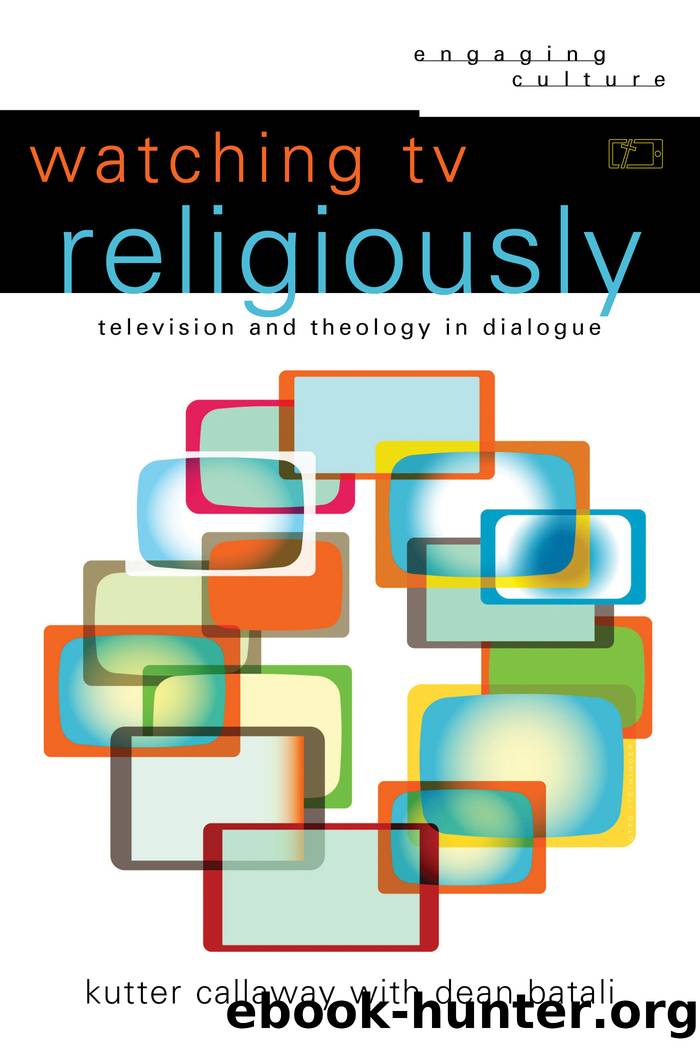Watching TV Religiously by Kutter Callaway

Author:Kutter Callaway
Language: eng
Format: epub
Tags: Television broadcasting—Religious aspects—Christianity;REL067000;REL012110;SOC022000
ISBN: 9781493405855
Publisher: Baker Publishing Group
Published: 2016-10-29T00:00:00+00:00
Communication as Ritual Formation
If communication is more than simply the transmission of information, then what exactly is it? And how might a broader theological conception of human communication enrich our engagement with the medium of television? Just as before, Augustineâs thought proves invaluable. One of his best-known lines comes from the opening of Confessions, which in many ways encapsulates Augustineâs theological anthropology: âour heart is restless until it rests in you.â17 To be human, for Augustine, is to desireâto be motivated by what we love. Yet because of human sinfulness, our love has become disoriented and misdirected, which is all the more tragic because we donât even realize that this is the case. Our desires are now directed toward something other than the true Source of all our affections.
Even though Augustine recognizes humanityâs basic disorientation, in no way does he urge the Christian to stop loving or desiring. This would be to abandon what makes us human. Rather, he suggests that we Christians ought to love ourselves and others âin Godâ and âfor the sake of God.â18 Instead of denying our erotic impulses (eros) in order to love faithfully (agape), Augustine suggests that agape is rightly ordered eros.19 So for Augustine, the problem is not desire itself. Instead, what holds humanity hostage is disoriented desire, an impulse no longer tethered to the Origin for which it longs.
Augustineâs picture of the human being as fundamentally a desiring creature is particularly helpful for our purposes because it offers a theological conception of how human communication works that is not limited to transmission alone. Interestingly enough, Augustineâs premodern notions of communication (as mediated by the body and driven by desire) anticipate recent developments within the humanities and the arts more broadly. Namely, there has been a decided shift among those exploring the significance of popular culture from a transmission view of communication to a âritual view.â As noted in chapter 3, Clive Marsh and Vaughan Roberts have outlined some of what this shift entails:
The ritual view focuses more on the relationship between communication and the culture of a gathered community. Much greater emphasis is placed on embodiment and body language, drama, visual elements, and use of space and time. . . . The move from a transmission view to a ritual view of communication means there is a shift away from the content of what is believed to how beliefs are shaped within religious communities. What people believe seems to matter less than the fact that a believer is a community member and an active participant in that communityâs ritual practices. Believers receive communication by virtue of their participation. This shift recognizes (again) the importance of religious practice, as opposed to simply religious belief.20
Despite our modern tendency to use metaphors taken from the world of digital technology, communication is not simply about âdownloadingâ bits of information onto a hard drive. It has to do with the way that embodied human beings are shaped by their ongoing, routinized participation in the life of a community.
Download
This site does not store any files on its server. We only index and link to content provided by other sites. Please contact the content providers to delete copyright contents if any and email us, we'll remove relevant links or contents immediately.
The 5 Love Languages: The Secret to Love That Lasts by Gary Chapman(9558)
The Space Between by Michelle L. Teichman(6840)
Assassin’s Fate by Robin Hobb(6102)
Wiseguy by Nicholas Pileggi(5648)
Everything Happens for a Reason by Kate Bowler(4659)
Gerald's Game by Stephen King(4556)
Pillow Thoughts by Courtney Peppernell(4188)
A Simplified Life by Emily Ley(4079)
The Power of Positive Thinking by Norman Vincent Peale(3985)
Harry Potter and the Prisoner of Azkaban (Book 3) by J. K. Rowling(3294)
Resisting Happiness by Matthew Kelly(3287)
Being Aware of Being Aware by Rupert Spira(3215)
Girl, Wash Your Face by Rachel Hollis(3192)
The Code Book by Simon Singh(3055)
More Language of Letting Go: 366 New Daily Meditations by Melody Beattie(2955)
Real Sex by Lauren F. Winner(2950)
The Secret Power of Speaking God's Word by Joyce Meyer(2929)
Name Book, The: Over 10,000 Names--Their Meanings, Origins, and Spiritual Significance by Astoria Dorothy(2926)
The Holy Spirit by Billy Graham(2880)
